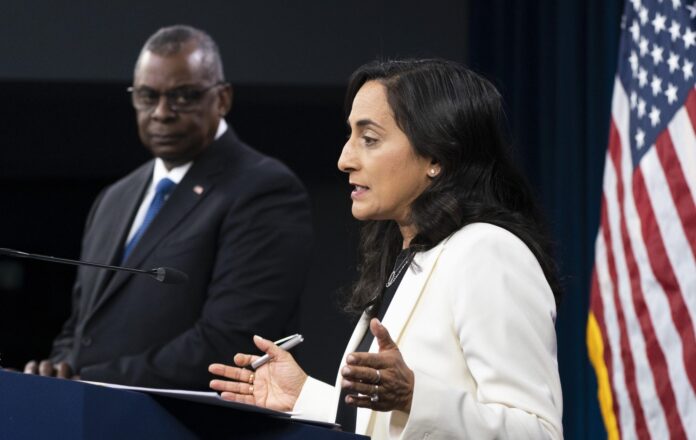Defence Minister Anita Anand’s first official visit to the Pentagon proved long on familiar diplomatic bromides Thursday, but offered little public-facing progress on urgent North American military priorities like the war in Ukraine or upgrading a badly outdated continental defence system.
Anand’s arrival — complete with a colour guard, marching-band renditions of the national anthems and a personal greeting from U.S. Defense Secretary Lloyd Austin — underlined the urgent nature of the geopolitical pressures reshaping the world from eastern Europe.
But the hour-long meeting and subsequent 20-minute news conference gave no substantive clues about Canada’s next steps on supporting Ukraine in its war with Russia or the pressing need to modernize Norad, the shared early-warning defence network that’s badly showing its age.
The closest Anand came was to confirm that Canadians are helping to train their Ukrainian counterparts on the hulking M777 cannons Canada delivered to the fight last week. Both she and Austin also made a point of mentioning the eight armoured vehicles that are due in the coming days.
Anand did not say where the training is happening. Defence sources say Canadian troops are not in Ukraine but working in a third country in eastern Europe.
The sources, speaking on condition of anonymity because they were not authorized to speak publicly, say Canada has sent four of the guns — fixtures of Canada’s 10-year war in Afghanistan that can lob shells as far as 30 kilometres — from 1 Royal Canadian Horse Artillery in Shilo, Man.
Anand also cited the more than $8 billion in military spending over the next five years that Canada promised in the federal budget earlier this month.
‘All hands on deck’ for Canada’s Ukraine response: Anand – Apr 17, 2022
But on the question of modernizing Norad in the face of an ambitious aggressor in Vladimir Putin and the mounting threat of high-tech long-range missile attacks from Russia and China, Anand said only that “we will have more to say on this in the short term.”
“At this crucial moment, Russia is testing the will of Canada, the United States and our allies and partners,” she said.
Trending Stories
Canada detects severe hepatitis of ‘unknown origin’ cases in kids. What is it?
Jeopardy! champ Mattea Roach’s winning streak reaches 17 games
“Russia cannot redraw maps at will to suit its own ends. Russia cannot erode the rules-based international order without consequences. Sovereign nations cannot be erased from the map. And NATO cannot be divided.”
The lack of any news on Norad was puzzling to University of Manitoba expert Andrea Charron, particularly as both countries have said repeatedly that modernizing North America’s defences is a top priority.
“I really don’t know where the problem is anymore,” Charron said. “I was all geared up for ‘Here we go Norad!’ and there was nothing.”
Charron said she’s encouraged, however, by reports of forthcoming plans for a new radar system that will detect threats approaching North American cities from over the Arctic. The radar, to be based in southern Canada, is expected to cost $1 billion.
Austin, meanwhile, was effusive in his praise for Canada’s efforts to date, even if they sounded paltry alongside President Joe Biden’s latest supplemental budget request of Congress: $US16 billion in additional money to backstop the war effort over the next “weeks and months.”
“Let me applaud you for everything that Canada is doing to help Ukraine defend itself,” Austin said, “including your extraordinary efforts to train Ukrainian forces through Operation Unifier” — the Canadian Armed Forces training mission in Ukraine.
“The United States and Canada are united in our admiration for the Ukrainian people’s bravery, and in our determination to help them defend their sovereignty.”
U.S. Secretary of Defense praises bravery of Ukrainian troops during visit to Germany
Both leaders acknowledged that the pace at which equipment, training and aid is being delivered is increasing by the day — Austin said it took just two days for howitzers from the $800-million package Biden signed last Thursday to show up on the battlefield.
“We are completely on the same page with our U.S. ally on the importance of the delivery of aid as soon as possible, as quickly as possible,” Anand said. Canada has a pair of heavy-lift aircraft operating out of Scotland that have delivered more than a million pounds of international aid to date, she added.
“This work continues every single day, so we will continue to deliver aid, including heavy weaponry, as quickly as possible, and will continue to work across the allied partnership to deliver aid writ large to Ukraine.”
Military officials have been warning for years that Norad, the 1980s-era system shared by the U.S. and Canada, is unable to detect the most perilous long-range and hypersonic threats. The two countries have long promised to bring the system into the 21st century.
“We reaffirm our commitment to supporting Norad’s ability to detect, deter, and defend against aerospace threats and to detect maritime threats to North America, today and in the future,” Anand’s predecessor Harjit Sajjan and Austin said in a joint statement last August, prior to Putin’s invasion.
“In particular, Norad must be able to detect and identify those threats earlier and respond to them faster and more decisively, including aerospace threats transiting our northern approaches.”
—With files from Lee Berthiaume in Ottawa
© 2022 The Canadian Press



